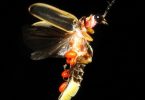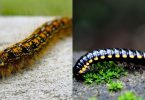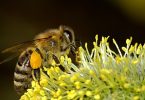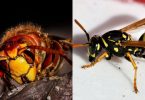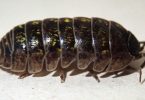Like other species of insects, the species of spiders are insects too and they go about building webs in the different places. In this article, we will be looking at a particular species of this insect spider; the spider with striped legs, the details that surrounds the species of spiders with striped legs. We will do this by describing the different kinds of species of spiders with striped legs.
1. Fishing Spiders

The Fishing Spiders type or specie of spiders with striped leg is such that appears to be quite aesthetic, though they are quite aggressive as well as very intimidating. The body of the fishing spider is covered in the colour brown, it also has markings of light brown colour and black colour too.
The fishing spiders are having banded rings on their legs and they are striped spiders because the banded rings have two colours which are the brown and the black colours. More so, the fishing spiders also have a trim of white, as well as six obvious spots on its abdomen while some of them have quite dark spots on its abdomen.
This species of spiders with striped legs equally has hairs that are fine although tiny on their body and legs. However, with the hydrophobic hairs of the fishing spiders, the species are able to walk freely on the surface of the water. More so, the height of this spider is not as intimidating as the height poses to be, this is because the entire body of the spider is only about three inches long.
The fishing spider has a different kind of eye which is made obvious by the arrangement of the eye. This species of spiders with striped legs has three rows of eyes; the first row of the eyes of the fishing spider has about four eyes on the straight line, same goes for the second and the third row, only that the pairs are on the second and third row are smaller than the size of the eyes on the front row.
It is also necessary to note that the fishing spider’s species of spiders with stripe legs are quite venomous, their poisons are mildly toxic and are harmful to tiny insects as well as other tiny creatures, but they are not harmful to humans except in a situation where the human bitten has an allergy relating to that venom. However, it is safer to stay away from them.
The fishing spiders inhabit areas with a lot of water, like the lakes, the ponds, the marshes, the rivers, the streams, and the woods. Also there have been times when the fishing spiders have been found in forest where they are hiding and searching for food. However, fishing spiders are predominantly inhabiting parts of the United States and Canada. They are also found in all of the other continents, but have not been spotted in Antarctica.
2.Golden Silk Orb-Weaver Spider
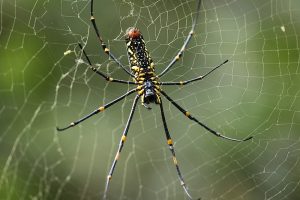
Golden Silk Orb-Weaver Spider is one of the species of spiders with striped legs. The body of this specie is cylindrical in shape, and is covered with patterns of yellow spots as well as silver carapace. The golden silk orb-weavers are spiders with striped legs because on their legs is a band that has an orange and a brown colour.
More so, the colour of the body of the golden silk orb-weaver ranges from the colour red to the colour green with a shade of yellow. More so, the size of the spider, including its legs is between one point five inches and two inches on the average. Although the female golden silk orb-weavers are in size slightly bigger than the males, however, their size is not as intimidating as their venom is.
More so, the orb-weaver has a very potent venom that is harmful to insects but not to humans, although when it bites it could result in pains, redness, and even blisters, which will disappear from the skin after a while but could live a mark depending on how deep the injury is. Whatever the case may be, it is best to stay off the bite of the golden silk-orb weaver.
Golden Silk Orb-Weaver Spiders species of spiders with striped legs mostly inhabit areas in warm or temperate regions, they also thrive on very high humidity as well as in open spaces which explains why they are found in very warm regions like Africa, Australia, and Asia. However, they are predominantly found in the United States, North Carolina and even in Texas.
3.Wolf Spider
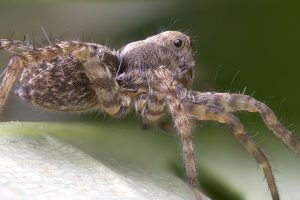
A Wolf Spider is quite an intimidating spider among spiders with striped legs, but this is only by its name; because on the average, the size of the entire body of the species of wolf spider is between zero point five centimeter and two point five centimeter although its quite long legs are not included, so the size could be intimidating after all.
The colour of the wolf spider is usually Tan, brown, black, or gray, but has dark markings as well as stripes. However, judging by its name again, the wolf spiders’ species of spiders with striped legs have their entire body, including their very long legs covered in hairs, although they are tiny hairs.
This species of animals with striped legs have three rows in which the eyes are arranged in pairs for each row. The top row has a pair of eyes that are medium in sizer, while the second row has a pair of eyes that are quite large in size, while the third row has a pair of four eyes that are small in size. These rows of eyes are very useful to the species of wolf spiders, which possibly suggests or rather accounts for the very sharp eye sight of the species.
The wolf spider has a venom that could leave its victims at the mercy of ailments, because although the venom could kill insects it is quite harmful to humans, in that when a human being is bitten by the wolf spider, the venom could result in issues like necrotic arachnidism which is mostly caused by the bacteria that infects the venom of a wolf spider.
The wolf spider species of spiders with striped legs are predominant inhabitants of different kinds of habitats which are mostly forests, grasslands, and woodlands. They are mostly found around the United Kingdom and North America, they are also found in their burrows around the windows and the doors of different houses and different buildings.
4.Zebra Spider
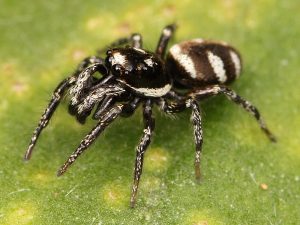
The species of the Zebra Spider, are named after the species of animal called zebra. This also evident because the species of zebra spider has its body covered in black and white stripes. They also have gray rings on the parts of their legs that mostly are either white in colour or brown in colour.
More so, with an average body size or length of about five millimeters and seven millimeters, the zebra spider is a small spider and is also a sturdy spider that can jump to a height that is fourteen times more than the height of their body when they decide to jump.
Zebra spiders are one the species of spiders that have striped legs which has very sharp eyesight. The eyes of the Zebra species of spiders are slightly different from the eyes of the rest, in that the zebra spider has a pair of quite large eye in the front row, and then a pair of six eyes that are scattered or rather fixed around the head, which gives them a three hundred and sixty degree look.
That is to say that because the head of the spider is surrounded by a pair of six eyes, the zebra species of spiders with striped legs are able to see different parts and even the entire parts of their environment at once.
It is important to know that the zebra species of spiders with striped legs are not very aggressive spiders; this is evident in how they attack, however they have a potent venom that helps them subdue and eventually feed on preys. However, on humans, the venom from the bite can only cause irritations that are mild, in some other cases they could result in injuries that could also be mild. The interesting and amazing thing is that the injury can be cured.
Another distinct feature of this species of spider is its ability to hunt its preys by the day. the zebra spider is a very agile spider, with quite swift reflexes, and its great eye sight. Although the size of the zebra spider is not big, what the zebra spider lacks in size, it already makes up for through its very amazing features.
More so, it is important to note that the Zebra species of spiders with striped leg prefer to be outdoors as well as to full engage their outdoor environments especially when the environment has lots of vegetation and very sufficient sunlight, which may also explain why it can jump about fourteen times higher than its size. The zebra species of spiders are predominantly found around North America, Britain, as well as around Europe.
5.Yellow Garden Spiders

The yellow garden spiders are species of spiders with striped legs that belong with the orb-weaving spiders, although they are a bit bigger than the orb-weavers. The yellow garden species of spider are also identified as spiders that write (writing spiders) especially because of the zig zag patterns with which they make their various webs. The size of the yellow garden spiders varies from genders.
For instance, the male yellow garden species is about six millimeters on the average, while the female yellow garden species of spider is about fourteen to twenty-four millimeters. So when you see a smaller yellow garden species of spider, chances are that you have seen a male yellow garden spider.
It is important to note that the adult yellow garden species of spiders with striped legs are mostly sexually dimorphic; which could be as a result of their sizes.
Apart from identifying the yellow garden species of spider by their different gender sizes, the female yellow garden spiders are easily pointed out as a result of the colour of the band on their carapace; the band on the carapace has two colours, the yellow colour and the black colour. And the pair of eyes of the yellow garden species is covered with tiny silver hairs.
Meanwhile, the male yellow garden spiders are mostly identified by their swollen as well as enlarged pedipalps, they are also identified by their colour; the colour of male yellow garden spider is brown. So apart from the size of male yellow garden spider, the colour and the size of its pedipalps are other means of identification.
The yellow garden spider has a potent venom with which they defend themselves from lurking attackers. Using its potent venom, the yellow garden spider paralyses its preys, and some of its preys include the bees, flies, and a whole range of different flying insects.
However, the venom of the yellow garden species of spiders with striped legs does not in any way at all harm humans. It gives them no irritation or injury, and it does not even bite except when it is disturbed or when it feels attached.
More so, like the zebra species of spiders with striped legs, the yellow garden species of spiders also likes to inhabit areas where there is very sufficient sunlight, gardens, bushes, as well as other structures they consider supportive enough to be an anchor that can hold their large webs. However, the yellow garden species of spider are found in Canada, Central America, and Mexico, but are predominantly found in North America.
6.Wasp Spider
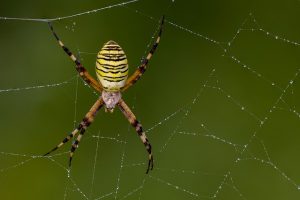
The wasp species of spiders with striped legs like the wasp bees is named after its colour; this is because the body of the wasp spider is covered in the patterns of yellow colour and black colour. The yellow black stripes are the major identification of wasps. The appearance of the wasp species of spider serves as a mechanism for defense which keeps the spider safe from its predators.
The difference between the female wasp species of spider and the male wasp species of spider is in its size. The female wasp species of spider are between fourteen millimeters to seventeen millimeters in size (14-17mm size) while the male wasp species of spider are between four millimeters to six millimeters in size.
More so, the wasp species of spiders with striped legs are one of the spiders with striped legs that have no potent venom in them. Although they could bite, but the bite of wasp spider does not necessarily lead to any serious injuries or risks, except for the pain that comes as a result of the insertion of fang in the body when it bites.
The wasp spiders like to inhabit areas where there are vegetation tall enough to anchor their webs, which is why they prefer to be in gardens, grasslands, farmlands, and woodland. Wasp species of spiders with striped legs are mostly found in the Mediterranean areas, although they are also found in parts of Africa, Asia, and Europe.
7.Giant Water Spider
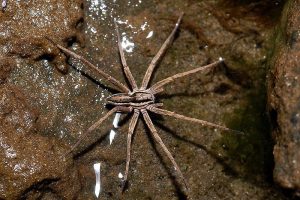
Giant Water Spiders are one of the largest hunting species of spiders with striped legs that can be found around water or water bodies. They also have prominent and different stripes with speckled patterns and hairs that are tiny around their entire body. The tiny hairs on its body traps and holds bubbles of air in the water which in turn gives the giant water spider a silver and shimmering appearance. The size of the adult spider is between the range of eight millimeters and fifteen millimeters (8-15mm).
The Giant water spider has venoms that are only effective on small vertebrates while the adult water spider when attacked or disturbed by humans can bite and inflict pain and blisters and even redness on the body of human as a result of their fangs.
Water Spiders inhabit water bodies like ponds, slow running waters, as well as other water bodies that are shallow, they also inhabit in aquatic vegetation and are found mostly around eastern Australia.
8.Brown Widow Spider

A Brown Widow spider shares a striking resemblance with the Black Widow spider, except that colour of the brown widow spider is either yellow with the blend of orange or red with shades orange while that of the black widow spider is bright red in colour.
Brown widows are also identified by the light coloration and banding which can be seen despite how dark the colour of the spider maybe. There is a mottling of brown and tan colour with black accent markings attached to its coloration. The size of the adult female brown spider is between one inch to one point five inches in length, while that of the male is about zero point five to zero point eight inches.
Brown widow spiders are found in the subtropical areas of Cyprus, Hawaii, Japan, Florida, and North America.



